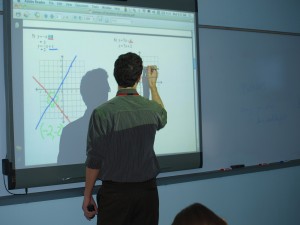By Lisa Flores
N-RN Rational Exponents
Alignment: HSN-RN.A.
1. Use the Product of a Power Property to simplify these expressions
(you may further simplify using the Negative Exponents Property):
a. (32a) · (ab3c)
b. (2d5g4) · (3gr) · (dr3)
c. (4ad) · (b-2c) · (2a-4b6)
2. Use the Power of a Product Property to simplify these expressions
(you may further simplify using the Negative Exponents Property):
a. (a2b3d)5
b. (3f4g5k)2 · (m0)4
c. (3r2t-2w)2 · (2-1s3t5)-3
3. Use the Product of a Power Property and the Power of a Product Property to simplify these expressions with rational exponents:
(you may further simplify using the Negative Exponents Property):
a. (a1/2bc3) · (ab1/3c)
b. (2d3fg)1/2 · (3e2f2g4)
c. (4-1rs5)1/5 · (5s3t-2/3)1/3
Commentary
This task combines skills in using the Product of a Power Property, Power of a Product Property, and Negative Exponents Property separately, and then together, in a gradually challenging manner. Each skill is to be used separately first so that the exponent property to be used is straightforward. Then, the expressions gradually become more challenging in order to prepare for the more-complicated expressions in section 3. Each of the expressions will help to develops skills in simplifying the next, more challenging expression. Ultimately, with practice in using each of the other three properties of exponents in the task, the students will be prepared to reach the math standard HSN-RN.A. Extend the properties of exponents to rational exponents.
In section 3, each expression has rational exponents. The three exponent properties must be used in order to simplify the expressions which may be left as a negative exponent (like 4-1/5) or as a reciprocal of an exponent. The expressions in section 3 require the use of all properties while working with rational exponents which aligns with the content standard HSN-RN.A. Extend the properties of exponents to rational exponents.
The tasks that help to reach the standard HSN-RN.A. “Extend the properties of exponents to rational exponents” support student understanding of separate exponent properties. With practice in using all of the properties of exponents, students will be prepared to proceed on to applying the properties in mathematical problems, like solving problems with functions that have multiple bases and exponents, for example.
Solution
1. Problem: Use the Product of a Power Property to simplify these expressions
(you may further simplify using the Negative Exponents Property):
a. (32a) · (ab3c)
b. (2d5g4) · (3gr) · (dr3)
c. (4ad) · (b-2c) · (2a-4b6)
Answer:
a. (32a)(ab3c) = 9a2b3c
The exponents are added when the bases are the same
b. (2d5g4)(3g2)(dr3) = 6d6g6r3
Although bases 2 and 3 are not the same base, they are multiplied because they have the same power
c. (4ad)(b-2c)(2a-4)(b6) = 8a-3b4cd or
2. Problem: Use the Power of a Product Property to simplify these expressions
(you may further simplify using the Negative Exponents Property):
a. (a2b3d)5
b. (3f4g5k)2 · (m0)4
c. (3r2t-2w)2 · (2-1s3t5)-3
Answer:
a. a10b15d5
The power outside the quantity is distributed to each base by multiplying the power of each base by the power of the quantity
b. 9f8g10k2m0 or 9f8g10k2
Any base to the power of 0 is equal to 1
c. (32r4t-4w2)(23s-9t-15) = 9 · 8r4s-9t-19w2 or
The answer may be left as a negative exponent or as a reciprocal of the exponent and its base, coefficients may be multiplied out or left as a product (9 times 8 or 72)
3. Problem: Use the Product of a Power Property and the Power of a Product Property to simplify these expressions with rational exponents:
(you may further simplify using the Negative Exponents Property):
a. (a1/2bc3) · (ab1/3c)
b. (2d3fg)1/2 · (3e2f2g4)
c. (4-1rs5)1/5 · (5s3t-2/3)1/3
Answer:
a. a3/2b4/3c4 or
Exponents are added using the Product of a Power Property
A whole number exponent and rational number exponent in the form of a fraction are added and left as a fraction or in radical form
b. (21/2d3/2f1/2g1/2)(3e2f2g4) = 3 · 21/2d3/2e2f5/2g9/2 or 3
Since bases 2, d, f, and g have their powers with the same denominator, they may be under the same radical
c. (4-1/5r1/5s1)(51/3s1t-2/9) = 4-1/551/3r1/5s2 t-2/9 or or
Answers may be left with exponents in the form of a fraction with negative exponents, as exponents in the form of a fraction with reciprocals of bases and their powers, or as exponents in the form of a radical with reciprocals.
Each answer given above is simplified further in each version.
Here is the worksheet with just the problems (title and CCSS-math alignment included): Assessment Item-just problems




